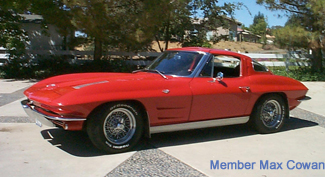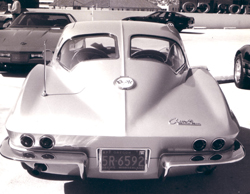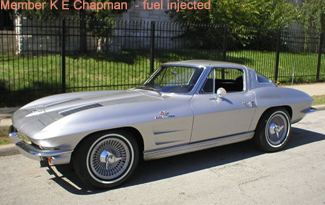 If you’re like many folks, when you hear "’63 ‘Vette," the first things that pop into your head are the words "Split-Window Coupe." It’s funny how a simple styling change like putting a division bar in the rear window can be such a significant (and to many, controversial) part of automotive history.
If you’re like many folks, when you hear "’63 ‘Vette," the first things that pop into your head are the words "Split-Window Coupe." It’s funny how a simple styling change like putting a division bar in the rear window can be such a significant (and to many, controversial) part of automotive history. The split-window look was one of those love-it-or-hate-it things. Many people liked it and the ‘63 Sting Ray Coupe became one of the most collectible Corvettes. The issue with the car’s design was that the division bar made it harder to see out the back. That meant you might have to use your rearview mirror to see how far you left your competition in the dust. 
The only contemporary American cars that could compete with the ’63 Corvette in terms of performance were all-out drag racers like the Ford Thunderbolt, Super-Stock Mopars and Super-Duty Pontiacs — cars that were made expressly for quartermile competition. The ‘63 Corvette was, hands-down, the fastest pure street machine you could own in its day.
Not everyone loved the split-window idea – and the most notable detractor was Corvette chief engineer Zora Arkus-Duntov, who felt it cluttered the driver’s rear vision. Zora lost the battle to styling chief Bill Mitchell, who wanted and insisted on the split-window design. Of course, other people had the same complaint about the design– that it made the car difficult to see out of.
From a styling standpoint, however, the split-window design definitely gave the car a little something. Its appearance was reminiscent of ‘49 and ‘57 Buicks and the ‘57 Olds, which had split-window themes of their own. The split-window concept had also been used on foreign exotics like the Bugatti.
One thing that few people complain about is the rest of the ’63 ‘Vette’s styling, though it certainly shocked many people when they saw just how different it was from it’s predecessors. GM took an entirely different direction with the ’63 ‘Vette and the effects can still be sensed today. You can see a hint of the ‘63 model’s personality in every Corvette that followed. It became a tougher, more aggressively-styled car than it had started out as. The Split-Window Corvette traded in the original "sports-car" image for a more race-oriented design that borrowed cues from Ferrari fastbacks.
The origins of the ‘63 ‘Vette make for one of the most interesting stories in Corvette history. The prototype was called the "Mitchell Sting Ray." It started out as the chassis from the prototype Corvette SS "mule" built in 1957. Bill Mitchell talked Chevrolet general manager Ed Cole into letting him buy it for a dollar to get around the corporate racing ban. He had Larry Shinoda design the body, taking cues from the looks of an actual Sting Ray fish. That might sound a little odd, but it definitely didn’t look odd. One glance at a ‘63 Corvette was enough to fall in love with the car. The concept was that good!
 When equipped with a new 360-hp fuel-injected 327, the Corvette could leave a lot of its competitors in the dust. A 5.6 second 0-to-60 time and a 14.2-second run through the traps were impressive performance numbers by any yardstick. The same applies to a top-end speed in the neighborhood of 150 mph.
When equipped with a new 360-hp fuel-injected 327, the Corvette could leave a lot of its competitors in the dust. A 5.6 second 0-to-60 time and a 14.2-second run through the traps were impressive performance numbers by any yardstick. The same applies to a top-end speed in the neighborhood of 150 mph. This was the year that the Corvette started to become a World-Class machine that could hold its own against the foreign competition, most of which cost several times more than the $4,257 base price of a ‘63 ‘Vette. This is another Corvette tradition that carries on to this day: it is an extremely fast car with a reasonable price tag considering all that you get for the money.
’63 VETTE FACTS
|
|
|
VEHICLE IDENTIFICATION NUMBER
|
30837S100001 through 30837S121513 Coupes. 30867S100001 through 30867S121513 Convertibles. The first symbol 3 indicated model year. The second and third symbol identified the body series 08 = Corvette. The fourth and fifth symbol indicated the body style 67 = convertible; 37 = coupe. The sixth symbol identified the assembly plant S = Saint Louis. The last six symbols indicate the sequential production number.
|
|
ENGINE
|
BASE ENGINE
Type: V-8
Bore and stroke: 4.00 x 3.25 in.
Displacement: 327 cid
Brake hp: 250 at 4400 rpm.
Induction: Carter Type AFB 4-bbl
OPTIONAL ENGINES:
327-cid/300-hp w/Carter AFB 4-bbl
327-cid/340-hp w/Carter AFB 4-bbl
327-cid/360-hp w/Ram-jet fuel injection
|
|
VITAL STATS
|
Coupe
Original Price: $4,252
Production: 10,594
Wheelbase: 98 in.
Length: 175.3 in.
Tires: 6.70 x 15
Convertible
Original Price: $4,037
Production: 10,919
Wheelbase: 98 in.
Length: 175.2 in.
Tires: 6.70 x 15
|
|
COOL STUFF
|
• First time Coupe body was available.
|